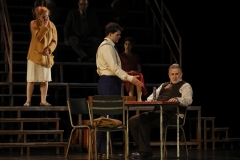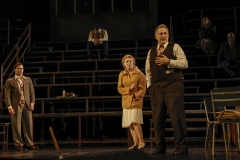Willy Loman is a man of great pride.
As a salesman for much of his 63 years, he has needed to be. Driving hundreds of miles to sell goods and living hand to mouth on his commissions. Back home Willy (Anthony LaPaglia)’s loyal and adoring wife Linda (Alison Whyte) holds down the fort. Keeping up with the never-ending bills and worrying about her husband day and night. But their mortgage is almost paid off. After 25 long years of hard work and struggles, the house is almost theirs.
But things aren’t as good as they seem. The couple’s two grown sons are back in their bedrooms visiting. Their eldest, Biff (Josh Helman) once a potential football star is now in his mid-30s and going nowhere in life. He argues with Willy constantly while their other son, Happy (Sean Keenan) a womaniser and scoundrel, attempts to keep the peace. Willy‘s behaviour has been growing odd lately and he’s been talking to himself more.
A confused Willy abandons a sales trip returning home in a daze and he seems to be worse than ever. This simple man has been dreaming of a brighter future for a long time, deluding himself to the realities of life in the present. Over the next few days some horrible truths will need to be confronted by Willy and his family. It’s time for everyone to stop lying and to pay attention.
From the start we can see that Willy is extremely troubled and is in no position to make cross-country trips. But this is what he feels like he needs to do and it is where he feels he belongs because it has been where he has always belonged.
GWB Entertainment and Red Line Productions present Arthur Miller’s Pulitzer prize-winning classic Death of a Salesman to Melbourne audiences. For over 75 years, Miller’s emotional and grounded examination of ‘the American dream’ has been a hit with audiences worldwide. The themes that are visited transcend generations and language barriers with the breakdown of a family, hope becoming a delusion, and not knowing your place in the world.
The play features an amazing cast of Australian actors, albeit playing Americans. Thankfully, there is no clumsy attempt to localise or modernise the setting and it is still set in late 1940s Brooklyn, New York. The play’s timeless quality is a mirror which will resonate with audiences with its characters being just as powerful now as they were when first written.
Making his Australian theatre debut is Emmy, Golden Globe, and Tony Award winning Anthony LaPaglia. The brilliant leading man won his Tony for the lead performance in a Broadway production of another Arthur Miller play, ‘A View from the Bridge’. Now, years later, he commands the stage in a role he is so perfect for, it feels like we’ve just been waiting for him to age into it.
Willy is a man of contradictions. He can be loving and humble one moment and brutish and despicable the next. But LaPaglia brings a tenderness to Willy which ensures we are always willing to care about him. Even when he finds himself in situations of his own making, he is at the end of the day just a deeply troubled man struggling with life.
Alison Whyte brings an authenticity to the role of the doting wife Linda to match LaPaglia‘s. At times it can be difficult to see her belittled or seemingly unappreciated by her husband. Her love for her man keeps her going and she never falters in being his rock. Linda’s real feelings and fears are revealed when talking to her two sons, and this is where Whyte really shines.
Of equal importance is the role of Biff and Josh Helman tackles it head on. Helman shows the physicality of the varsity athlete Willy knows he can be. But also, the damaged soul of a man who lost all hope early on and has just been coasting ever since.
Sean Keenan must not be overlooked as the feckless son ironically named Happy. Many of his scenes intentionally bring awkward laughs from the audience. His attempts to step out of his brother’s shadow or to keep the peace at home are almost comical. But they are also extremely sad as Happy’s life lacks true meaning, always trying to be ‘the good son’ and being rewarded with apathy.
The cast of supporting players faithfully bring just the right context to the story of the Loman family, along with Steve Bastoni‘s portrayal of the wisecracking neighbour Charley being a personal favourite. His simpler outlook on life is the opposite to Willy‘s but he is at least a man who understands where he is in life.
The set design by Dale Ferguson is both minimalist yet abstract. I believe the traditional Death of a Salesman set depicts the Loman household. Yet here we are presented with the bleachers of Ebbets Field ballpark where a young Biff once showed off his greatness. The cast sit high in these seats watching the show like spectres in the back of Willy’s fractured psyche. Making full use of the stage, lighting by Niklas Pajanti draws our focus only to where it needs to be.
Considered one of the greatest American plays, there is little I can say about Death of a Salesman which has not been said already. Arthur Miller’s seminal tragedy of a man facing his own redundancy remains as powerful now as it ever was. With a brilliant cast of Australian actors, director Neil Armfield successfully continues Death of a Salesman’s fine legacy.
Death of a Salesman is currently playing in Melbourne at Her Majesty’s Theatre for a limited 7-week season until October 15th.
For more information and ticketing, visit:
https://salesmanaustralia.com.au
Photography by Jeff Busby.


